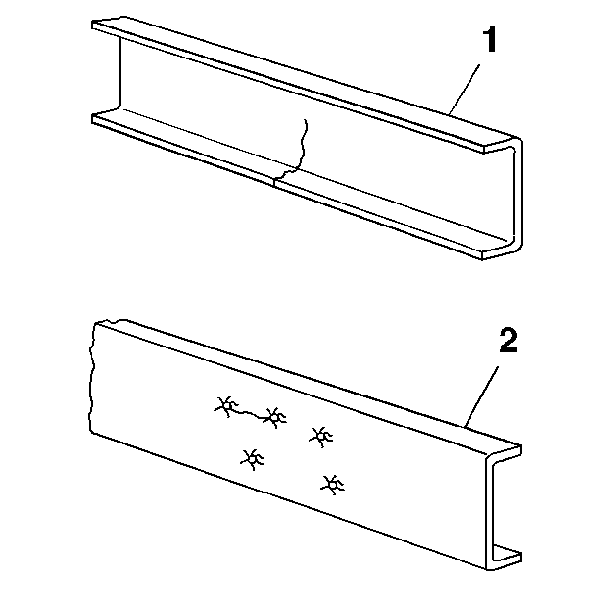Straightening Procedure
Frame straightening can be complicated. Frame straightening usually requires the use of special equipment. Only trained technicians should straighten the frame.
Completely analyze the situation before you perform any steps to repair the frame. Knowing the cause of the problem will help you determine the correct sequence of repair steps.
Reverse the flow of damaging forces. In many cases, this requires that you apply pressure from different directions at the same time.
Use controlled heat carefully. Too much or too little heat may be a source of trouble.
The following procedures are recommended:
- Heat the area that you will stretch in order to straighten the frame.
- Heat the area after you exert sufficient pressure in order to cause a slight checking or silvery cracks to appear on the surface of the metal. Gradually increase the pressure while heating.
- Do not heat the area to more than 606°C (1200°F). A red glow means that the material is overheated. Overheating causes the following conditions:
| • | Distortion |
| • | Stretching |
| • | A change in characteristics of the metal |
Crack Repair

There are 2 common types of cracks:
| • | Straight crack (1) |
| • | Sunburst cracks (2) |
The straight crack (1) usually travels from the edge of a flange, across the flange, through the web section of a rail, and through the other flange. A straight crack results from the following conditions:
| • | High concentrations of stress in small areas of the frame |
| • | Excessive bending movement |
| • | Torsional loading |
The sunburst crack (2) radiates from a hole in the web section of a rail or a crossmember. Heavy loads and a loose mounting bracket or crossmember may cause a sunburst crack.
If both the rail and the reinforcement are cracked in a particular area of the frame, repair the rail and the reinforcement separately. Flanges must react independently in order to prevent localized stress.
Use a copper spacer between the flanges of cracked base rail flanges and reinforcement flanges.
Repair the crossmember mounting flange crack in the same manner as the side rail crack. Build up weld bead in order to provide a good, smooth radius. Replace a damaged crossmember.
You may have to align the frame and level the rails before you repair the frame.
Follow these steps in order to repair a crack:
- Remove any equipment that hinders access to the crack.
- Find the extreme end of the crack and drill a 6 mm (0.25 in) hole.
- Open up a 2 mm (1/16 in) chamfer at the bottom of the crack in order to allow good penetration of the weld.
- Repair the crack with the proper electrode and welding techniques.
- Grind the weld smooth on the inside and the outside of the rail or crossmember. Carefully eliminate weld buildup or notches on the edge of the flange.
V grind the entire length of the crack, from the starting point to the 6 mm (0.25 in) hole at the extreme end.
